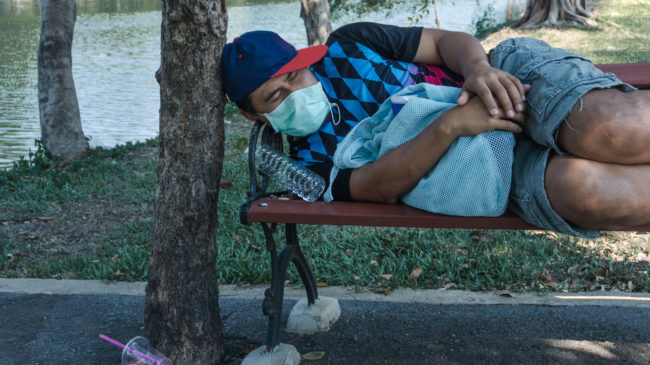In the debate about the best public response to the coronavirus, pundits and policymakers have too often completely dismissed or failed to fully assess the serious risks to human life posed by a global halt to economic production.
The tragedy of 170,000 worldwide COVID-19 deaths and the risks from exposure to it, particularly for vulnerable populations, are obvious. Unfortunately, the risks stemming from a collapse of economic production are often framed in purely financial terms, whereas economic production exists for the benefit of human welfare.
The response to COVID-19 is unprecedented in human history. Many governments around the world have simultaneously ordered a halt to most forms of economic activity. In the United States alone, JP Morgan forecasts a staggering 40 percent decline in the gross domestic product (GDP) for the second quarter of 2020. James Bullard, president of the Federal Reserve Bank of St. Louis, forecasts an even steeper 50 percent drop in second-quarter GDP, with unemployment rising to 30 percent.
Numerous nations around the globe have implemented shutdowns much like the US and could be affected similarly, which would mean a sharp decline in global output. Further, there are reasons to believe these economic contractions may not be short-lived. Few businesses maintain sufficient cash reserves to service fixed costs while suffering a sudden, near-total collapse of revenue over an indefinite time period. As a result, many businesses have already closed, or are expected to close, permanently during the government-mandated COVID-19 shutdowns.
These closures have already constrained global supply chains, including systems for food and agricultural products. These dislocations are leading to supply shortages in the short term, as many manufacturers cannot procure their needed input materials and as farmers in the Southern Hemisphere struggle to get crops to market.
The permanent closure of many businesses within those supply chains, however, could mean that shortages continue beyond the short-term. Sure, the sudden disappearance of critical cogs within those supply chains creates new entrepreneurial opportunities for businesses that will replace or change the functions previously held by these defunct businesses. However, the process of building a large mass of new businesses is slow and will likely become more difficult as people become more hesitant to put whatever cash they still have available at risk. Many individuals are now forced to use what cash they have just to pay rent and buy food, so the amount of capital available for investment in new businesses will be depressed over the foreseeable future.
These potential issues pose a grave danger to human welfare because individuals may not be able to procure the basic necessities of life such as food, clothing, or medical care. Indeed, the economic downturn created by governments’ response to this pandemic is substantively different than that of prior recessions. If an individual was able to sustain his or her income during the 2007-2009 recession, for instance, there were still items available for that person to buy. In contrast, the supply chain dislocations caused by COVID-19 and the consequent shutdowns appear likely to constrain both incomes and the general availability of goods.
If the aforementioned forecasts for potential declines in gross domestic product prove accurate, second-quarter production in the United States would fall to about 1995 levels in real terms, according to data from the U.S. Bureau of Economic Analysis. In 1995, about 30 percent of the world’s population lived in extreme poverty, according to data from the World Bank. Expansion of international trade and rapid economic growth since that time have combined to lift billions of people out of extreme poverty. By 2015, less than 10 percent of the world lived in extreme poverty, according to World Bank data.
A global collapse in economic production to 1995 levels could expose untold millions of people to conditions of extreme poverty once again. Individuals around the world could suffer the twin dangers of rising prices that result from reduced global production and falling incomes as unemployment skyrockets. Suddenly, millions of people who were out of poverty, or people who have never been impoverished, will no longer be able to afford or even find basic items they were previously able to purchase. This chain of events could have significant adverse effects on human health. For instance, in its 1995 World Health Report, the World Health Organization said:
The world’s biggest killer and the greatest cause of ill-health and suffering across the globe is…extreme poverty. Poverty is the main reason why babies are not vaccinated, why clean water and sanitation are not provided, why curative drugs and other treatments are unavailable and why mothers die in childbirth. It is the underlying cause of reduced life expectancy, handicap, disability and starvation.
Accordingly, the United Nations now warns that hundreds of thousands of children around the world could die this year as a direct result of the economic downturn sparked by the pandemic and related government shutdowns. The UN reports that 188 countries have imposed closures and that 42 million to 66 million children could fall back into extreme poverty this year.
Even in the developed world, the quality and length of life tend to decline as a result of a severe economic downturn. Research published in the Journal of Epidemiology & Community Health in 2003 found that unemployment can severely damage mental health and is associated with a twofold to threefold increase in suicide rates. Unemployment is also associated with a rise in alcoholism and other substance abuse, a 2011 study published in Current Drug Abuse Reviews found. According to a peer-reviewed article in the Annual Review of Sociology:
Research suggests that displacement is associated with subsequent unemployment, long-term earnings losses, and lower job quality; declines in psychological and physical well-being; loss of psychosocial assets; social withdrawal; family disruption; and lower levels of children’s attainment and well-being. Although reemployment mitigates some of the negative effects of job loss, it does not eliminate them.
As governments continue to fight the pandemic and consider reopening economies, it’s important to take a full accounting of the types of potential risks to human life posed by the worldwide shutdowns on economic activity in order to soberly assess the trade-offs of allowing that activity to recommence.
Human life can be harmed from economic shutdowns as well as from exposure to COVID-19.

